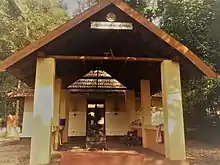Kartha or Karthavu, meaning "Lord" in the Malayalam language, is an aristocratic Nair title which traditionally meant, "One who does." It was conferred by the kings of Kerala to powerful Nair families, and as such, they enjoyed Raja (regional kings) or Naduvazhi (feudal chieftains and landlords) status. [1] Kartha chieftains were also bestowed with extraordinary rights and authorities by the erstwhile kings and they held a special status within the royal court. They used these privileges to own vast acres of land (Jenmi).[2] History has it that some members of the Kartha community also used to work as Supreme Commanders in the royal armies of the king, while other Kartha families were renowned for their expertise in traditional Ayurveda medicine.[3] Most Kartha families have their ancestral tutelary deity as the Hindu Goddess Bhadrakali, or the Goddess Durga. A few families also consider their ancestral deity as Vettakkorumakan, a Hindu entity worshiped in parts of North Kerala.
Kaimal is a closely related Cast/Title Both Kartha and Kaimal are identified as Samanthan. Those who belong to the old Royal families are styled Rāja or Tamburān (lord), their ladies Tamburāttis, and their houses Kōvilagams or palaces. Some Sāmantans have the caste titles of Kartāvu and Kaimal. But it does not appear that there are really any material differences between the various classes of Sāmantans, other than purely social differences due to their relative wealth and influence. [4]

Kartha and Kaimals identify themselves as a Nair sub-cast with Kshatriya Varna. There are many references recorded in various historical documents. They are noted as Kings/Nadivazis(നാടുവാഴി)/ Princes.[5][6]
[7]
[8]
[9]
[10][11]
Social Role
The Karthas, as a community, ruled regional principalities and fiefdoms, served in the royal armies or worked as Tax Collectors for the kings. They also served as military commanders and feudal chieftains. The Kartha surname is still used today, although it is less prominent.
The title of Kartha ("Lord") appears to have been used as a titular name by some of the rulers of Madura. During the Madras Census of 1901, the title of Kartha was returned by the Balijas who claimed to be the descendants of the Nayak kings of Madura and Tanjore. The Tekkumkur and Vadakkumkur Rajas are said to have first conferred the title of Kartha on certain influential Nair families who were related by blood to the Rajas themselves. In social matters, the authority of the Kartha was supreme. Only on important issues were higher authorities called on to intercede. [12]
As per historical records, such as the 'International Congress on Kerala Studies', it states that Territorial rulers titled Kaimal and Kartha ran parallel administrative systems by even challenging Kings( Maha Raja) [13]
Caste system
Most Karthas belong to the Illam Nair subdivision of the Nair caste, while a few were from the Kiryathil Nair subdivision.[14]
See also
References
- ↑ Fuller, Christopher John (30 December 1976). The Nayars Today. Cambridge University Press. ISBN 978-0-521-29091-3.
{{cite book}}:|journal=ignored (help) - ↑ Thurston, Edgar (1909). Castes and Tribes of Southern India. Gutenberg Publications. ISBN 978-1113560315.
- ↑ "Mevada Thampans renowned Thamban Vaidyan Kartha Family". 27 April 2020. Archived from the original on 27 April 2020. Retrieved 27 April 2020.
- ↑ Thurston, Edgar. O. (1909). Castes and Tribes of Southern India, by Edgar Thurston. Publications. p. 286.
- ↑ Journal of Kerala Studies. University of Kerala. 2005.
- ↑ Journal of Kerala Studies/. University of Kerala. 2005.
- ↑ The Cochin State Manual. Cochin Govt Press, Year 1911. 1911.
- ↑ Journal of Kerala Studies. Cochin Govt Press, Year 1911. 2005.
- ↑ From Biography to History Essays in the History of Portuguese Asia (1500-1800). The University of Virginia. 2005. ISBN 9788189420017.
- ↑ Madras Christian College Magazine, Page 411. Madras Christian College, year 1910. 1910.
- ↑
Kaimal,” the title of a prince of the Nayar caste in Malabar (Dalgado I 172-173). (1977). "Francis Xavier: His Life, his times - vol. 2: India, 1541-1545". The Jesuits Historical Institute, 1977.
{{cite web}}: CS1 maint: numeric names: authors list (link) - ↑ "Full text of "Castes and tribes of southern India"". Retrieved 22 September 2013.
- ↑ International Congress on Kerala Studies. the University of Michigan. 1994.
- ↑ Thurston, Edgar (1909). "Castes and Tribes of Southern India". 5: 295.
{{cite journal}}: Cite journal requires|journal=(help)